Lens System Summary
JVAS lens B0218+357 is a double-image lens with an Einstein ring and a maximum image separation of 335 milli-arcseconds (A. R. Patnaik et al.). This is the smallest separation known for a galactic-mass lens. Other interesting features include high radio polarisation (~10%), high faraday rotation, depolarisation of image A at frequencies of 15GHz and below and extensive frequency-dependent radio structure. It has some of the highest molecular and HI absorptions of any lens and also has (probably) high extinction of image A. It exhibits a radio time delay of 10.5±0.5 days (A. D. Biggs et al.), and is a good candidate for the measurement of H0. The received flux density exceeds 1.2Jy at 8.4GHz, making it one of the brightest lenses in the CLASS/JVAS sample.
|
This Lens System
|
Lens name
|
B0218+357
|
|
Survey
|
JVAS
|
|
Images
|
2
|
|
B1950.0 coords
|
02h18m04.129s
|
35°42'31.830"
|
|
J2000.0 coords
|
02h21m05.470s
|
35°56'13.723"
|
|
Lens System Structure and Labelling
Image labelling for this lens (RA increases to the left, declination increases upwards)
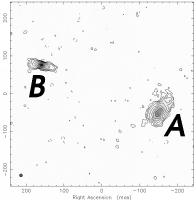
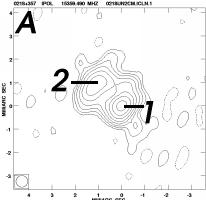
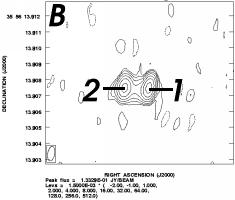
|
Image/Lens Positions
Relative positions obtained from 15GHz VLBA observations (see Patnaik, Porcas and Browne 1995)
|
Image/Lens
|
Relative Position
|
|
East (mas)
|
North (mas)
|
|
A1
|
+0.0
|
+0.0
|
|
A2
|
+1.07
|
+0.86
|
|
B1
|
+309.2
|
+127.4
|
|
B2
|
+310.6
|
+127.4
|
|
Image/Lens Separations
|
Separation (mas)
|
|
Component
|
A1
|
A2
|
B1
|
B2
|
|
A1
|
|
1.4
|
334.4
|
335.7
|
|
A2
|
1.4
|
|
333.1
|
334.4
|
|
B1
|
334.4
|
333.1
|
|
1.4
|
|
B2
|
335.7
|
334.4
|
1.4
|
|
|
Position angle (°)
|
|
Component
|
A1
|
A2
|
B1
|
B2
|
|
A1
|
|
-128.8
|
-112.4
|
-112.3
|
|
A2
|
51.2
|
|
-112.3
|
-112.2
|
|
B1
|
67.6
|
67.7
|
|
-90.0
|
|
B2
|
67.7
|
67.8
|
90.0
|
|
|
Maps and Images
Click on an image to see a larger JPEG version, or click on the accompanying text to
download a gzipped FITS or PostScript file of the map or image. The images and maps are
available in one gzipped file here.
To see a DSS image of the region around this lens, click here - note that you will have to start the search manually by clicking on the 'Search' button.
|
Discovery images
|
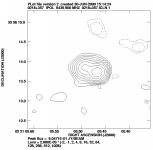
Discovery map, VLA 8.4GHz
I. Browne
|
|
|
|
Optical and IR images
|
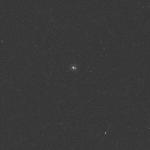
V-band WFPC-2 image
Jackson et al.
|
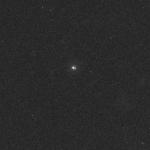
I-band WFPC-2 image
Jackson et al.
|
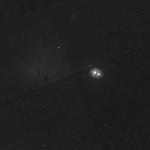
H-band NICMOS image
Jackson et al.
|
Maps of the
Einsten ring
|
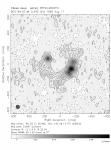
Einstein ring at 340MHz, VLBA (50 mas)
P. N. Wilkinson
|
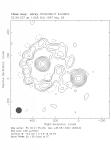
Einstein ring at 1.7GHz, EVN (50 mas)
A. R. Patnaik
|
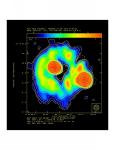
Extended structure, 5GHz MERLIN/VLA
A. D. Biggs
|
|
|
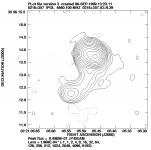
Lens images & jet, 5GHz VLA (350 mas)
A. D. Biggs
|
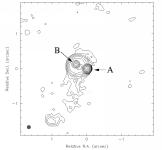
Extended structure, 15GHz VLA
A. D. Biggs
|
|
|
Radio maps showing A+B
|
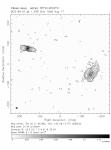
Components A+B, 1.4GHz VLBA (8 mas)
P. N. Wilkinson
|
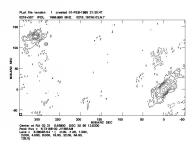
Components A+B, 1.7GHz VLBA (5 mas)
P. N. Wilkinson
|
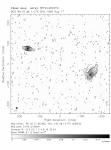
Components A+B, 1.7GHz VLBA (8 mas)
P. N. Wilkinson
|
|
|
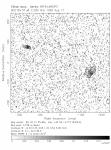
Components A+B, 2.3GHz VLBA (5 mas)
P. N. Wilkinson
|
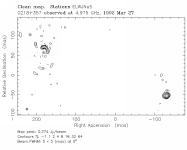
Components A+B, 5GHz VLBI (8 mas)
P. N. Wilkinson
|
|
|
Radio maps of image A
|
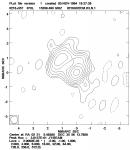
Component A, 15GHz VLBA (0.5 mas)
Patnaik et al.
|
|
|
|
Radio maps of image B
|
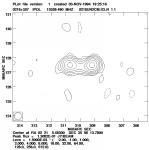
Component B, 15GHz VLBA (0.5 mas)
Patnaik et al.
|
|
|
|
Radio Flux Densities
|
Component
|
Flux density (mJy)
|
|
1.465 GHz
|
1.63 GHz
|
1.7 GHz
|
4.84 GHz
|
5 GHz
|
5 GHz
|
5 GHz
|
8.4 GHz
|
8.4 GHz
|
8.4 GHz
|
8.4 GHz
|
15 GHz
|
15 GHz
|
15.3 GHz
|
22 GHz
|
22 GHz
|
22.4 GHz
|
43 GHz
|
|
Total
|
~770 mJy/beam
(peak)
|
|
|
|
|
|
|
|
|
|
|
|
|
|
|
|
|
|
|
Ring
|
|
|
|
133±13
|
236
|
|
|
158±16
|
186
|
|
|
126
|
|
|
101
|
|
167±40
|
|
|
A
|
|
|
445
|
880±80
|
728
|
660
|
515
|
807±40
|
767
|
|
|
698
|
|
|
654
|
|
833±160
|
|
|
A1
|
|
|
|
|
|
410
|
|
|
|
554±25
|
472
|
|
450
|
621±7
|
|
328
|
|
270
|
|
A2
|
|
|
|
|
|
250
|
|
|
|
223±5
|
218
|
|
121
|
379±5
|
|
100
|
|
75
|
|
B
|
|
|
170
|
370±20
|
245
|
210
|
196
|
271±15
|
236
|
|
|
189
|
|
|
180
|
|
253±50
|
|
|
B1
|
|
|
|
|
|
|
|
|
|
171±5
|
139
|
|
295
|
172±3
|
|
140
|
|
60
|
|
B2
|
|
|
|
|
|
|
|
|
|
59.9±3
|
63
|
|
66
|
104±3
|
|
41
|
|
22
|
Extended
structure
|
|
≥120
|
|
|
|
|
|
|
|
|
|
|
|
|
|
|
|
|
|
Flux errors
|
|
|
|
|
|
|
|
|
|
|
|
|
|
|
|
|
|
|
|
Resolution (mas)
|
4900
|
|
5
|
|
50
|
5
|
1
|
|
200
|
1.3
|
1
|
120
|
0.5
|
0.5
|
|
0.3
|
|
0.2
|
Map noise level
(mJy/beam)
|
|
|
|
|
|
|
|
|
|
|
|
|
|
0.6
|
|
|
|
|
|
Instrument
|
VLA
|
VLA
A + C arrays
|
VLBI (mk3)
|
VLA
|
MERLIN
|
EVN
|
VLBI
|
|
VLA
|
VLBI
|
VLBI
|
VLA
|
VLBI
|
VLBA
|
VLA
|
VLBI
|
VLA
|
VLBI
|
|
Date observed
|
1991/11/16
|
1990/02/09 (A)
1989/07/09 (C)
|
1992/06/19
|
1990/02/09
|
1991/08/26
|
1990/11/19
|
1992/03/27
|
1990/02/09
|
1991/08/01
|
1995/05/09
|
1995/05/09
|
1991/08/01
|
1995/07/17
|
1994/10/03
|
1991/08/01
|
1995/07/17
|
1990/02/09
|
1995/07/17
|
|
Reference
|
[3]
|
[2]
|
[5]
|
[2]
|
[3]
|
[3]
|
[5]
|
[2]
|
[3]
|
[19]
|
[5]
|
[3]
|
[5]
|
[6]
|
[3]
|
[5]
|
[2]
|
[5]
|
|
Optical Imaging
|
Component
|
Brightness (Magnitudes)
|
|
F555W (V)
|
F814W (I)
|
F160W (H)
|
r
|
Spinrad R (rs)
|
U
|
|
A
|
23.1±0.3
|
21.5±0.3
|
17.386±0.09
|
|
|
|
|
B
|
21.06±0.08
|
19.09±0.11
|
16.89±0.06
|
|
|
|
|
Lensing galaxy
|
21.9±0.4
|
19.51±0.17
|
17.1±0.1
|
|
|
|
|
Total
|
|
|
|
20.0
|
18.9
|
21.5
|
|
Instrument
|
WFPC2 (HST)
|
WFPC2 (HST)
|
NIC1/NICMOS (HST)
|
NOT 2.5-m
|
Lick 3-m
|
Lick 3-m
|
|
Integration time
|
|
|
7870 sec
in 6exp.
|
2200 sec
|
1200 sec
|
1800 sec
|
|
PSF size (arcsec)
|
0.65
|
0.79
|
0.131
|
1.0
|
2.1
1.5
|
1.5
|
|
Pixel scale (mas/pixel)
|
45.5
|
45.5
|
43
|
200
|
|
|
|
Date observed
|
|
|
1997/08/07
|
1991/11/07
|
1991/10/11
1991/12/13
|
1991/12/13
|
|
Reference no.
|
[15]
|
[15]
|
[15]
|
[2]
|
[2]
|
[2]
|
|
Radio Image Polarisations
|
Image
|
Radio Polarisation(%)
|
Polarisation angle(°)
|
|
8.4 GHz
|
8.4 GHz
|
15 GHz
|
22 GHz
|
22.4 GHz
|
8.4 GHz
|
8.4 GHz
|
15 GHz
|
22 GHz
|
22.4 GHz
|
|
A
|
6.4±0.1
|
6.4
|
10.5
|
10.1
|
10.8±0.5
|
46.6±2
|
46
|
73
|
58
|
74±10
|
|
B
|
8.1±0.1
|
8.0
|
9.4
|
9.4
|
9.6±0.5
|
105.7±2
|
108
|
90
|
63
|
80±10
|
|
Resolution (mas)
|
|
200
|
119x113
|
|
|
|
200
|
119x113
|
|
|
|
Map noise level
|
|
|
|
|
|
|
|
|
|
|
|
Instrument
|
VLA
|
VLA
|
VLA
|
VLA
|
VLA
|
VLA
|
VLA
|
VLA
|
VLA
|
VLA
|
|
Date observed
|
1990/02/09
|
1991/08/01
|
1991/08/01
|
1991/08/01
|
1990/02/09
|
1990/02/09
|
1991/08/01
|
1991/08/01
|
1991/08/01
|
1990/02/09
|
|
Reference no.
|
[2]
|
[3]
|
[3]
|
[3]
|
[2]
|
[2]
|
[3]
|
[3]
|
[3]
|
[2]
|
|
Redshifts
|
Object
|
Redshift
|
Instrument
|
Date Observed
|
Reference
|
|
Lens galaxy
|
0.6847
|
ISIS (WHT)
|
1992/10/29
|
[4]
|
|
Source
|
0.944±0.002
|
LRIS (Keck)
|
1994/09
1995
1996
1997
2000
|
[21]
|
|
Notes
World's Smallest Einstein Ring (335 mas in diameter)
Prime candidate for determination of H0, variable in radio and possibly optical, time delay measured by Biggs et al. (1999) to be 10.5±0.4 days, giving a value for H0 of 69+13-19 kms-1 Mpc-1
Cohen et al. find a time delay of 10.1+1.5-1.6 days (95% confidence) from VLA measurements taken (independently) over same epoch as Biggs et al. (1999), and determine H0 = 71+17-23 km s-1 Mpc-1 for Ω0 = 1 and Λ0 = 0 (95% confidence, in absence of systematics).
Difficulty in establishing position of lensing galaxy continues to limit attempts to model this system.
Forthcoming observations with the ACS on the HST are designed to locate the lensing galaxy.
|
References
Click here to see the CASTLES data available for this object, or here to search for references on NED. You can go to a paper's abstract on ADS by clicking its reference number.
-
[1] Interferometer phase calibrator sources (1), A. R. Patnaik et al., Mon. Not. R. Astron. Soc. 254, pp. 655-676 (1992)
-
[2] Radio and optical observations of 0218+357 - The smallest Einstein ring?, C. P. O'Dea et al., Astron. J. (ISSN 0004-6256) 104, no. 4, 1320-1330 (1992)
-
[3] B0218+35.7: a gravitationally lensed system with the smallest separation, A. R. Patnaik et al., Mon. Not. R. Astron. Soc. 261, 435-444 (1993)
-
[4] The Redshift of the Lensing Galaxy in the Gravitationally Lensed System B:0218+35.7, I. W. A. Browne et al., Mon. Not. R. Astron. Soc. 263, L32 (1993)
-
[5] Frequency dependent radio structure of the gravitational lens system B0218+357, A. R. Patnaik and R. W. Porcas, H.R.R.L. (ASP Conf. Series Vol. 156) ISBN 1-886733-76-7, p. 247.
-
[6] VLBA observations of the gravitational lens system B0218+357, A. R. Patnaik et al., Mon. Not. R. Astron. Soc. 274, L5-L7 (1995)
-
[7] The optical appearance of the gravitational lens system B0218+357, F. Grundahl and J. Hjorth, Mon. Not. R. Astron. Soc. 275, L67-L71 (1995)
-
[8] A lens model for B0218+357, S. Nair, Astrophysical applications of gravitational lensing (173rd Symposium of the IAU p. 197) (1996)
-
[9] Radio measurement of the time delay in 0218+357, E. A. Corbett et al., Astrophysical applications of gravitational lensing (173rd Symposium of the IAU p.37) (1996)
-
[10] Observations of lens systems with Keck I, C. R. Lawrence et al., Astrophysical applications of gravitational lensing (173rd Symposium of the IAU p.299) (1996)
-
[11] Multi-frequency VLBI Observations of the Gravitational Lens B0218+ 357, R. W. Porcas and A. R. Patnaik, Extragalactic radio sources: proceedings of the 175th Symposium of the IAU p.115) (1996)
-
[12] PhD Thesis, A. D. Biggs (1999)
-
[13] Time delay for the gravitational lens system B0218+357, A. D. Biggs et al., Mon. Not. R. Astron. Soc. 304, 349-358 (1999)
-
[14] Gravitationally lensed radio sources in the Jodrell Bank-VLA Astrometric Survey, L. J. King et al., Mon. Not. R. Astron. Soc. 307, pp. 225-235 (1999)
-
[15] NICMOS images of JVAS/CLASS gravitational lens systems, N. Jackson et al., Mon. Not. R. Astron. Soc. 311, pp. 389-396 (2000)
-
[16] Further Investigation of the Time Delay, Magnification Ratios, and Variability in the Gravitational Lens 0218+357, A. S. Cohen et al., Astrophys. J. 545, Iss. 2, pp. 578-590 (2000)
-
[17] MERLIN/VLA imaging of the gravitational lens system B0218+357, A. D. Biggs et al., Mon. Not. R. Astron. Soc. 322, p. 821 (2001)
-
[18] Intrinsic intraday variability in the gravitational lens system B0218+357, A. D. Biggs et al., Mon. Not. R. Astron. Soc. 323, pp. 995-998 (2001)
-
[19] Polarization VLBI Observations of the Gravitational Lens System B0218+357 at 8.4 GHz, A. J. Kemball et al., Astrophys. J. 562, p. 649 (2001)
-
[20] Global 8.4-GHz VLBI observations of JVAS B0218+357, A. D. Biggs et al., Accepted by Mon. Not. R. Astron. Soc. (astro-ph/0209182: 2002)
-
[21] The Redshift of the Lensed Object in the Einstein Ring B0218+357, J. G. Cohen, C. R. Lawrence and R. D. Blandford, Accepted by Astrophys. J. (astro-ph/0209457: 2002)
|
Click here to go back to the database index page, or here to go back to the top of this page. |


